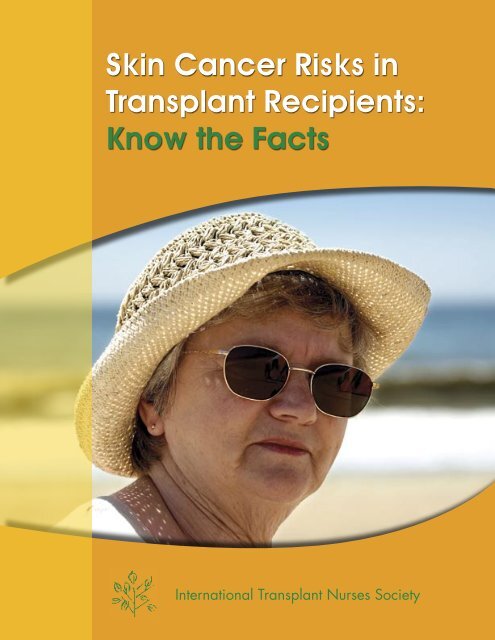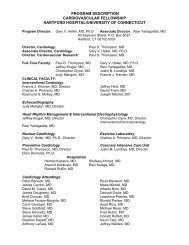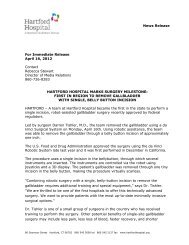Skin Cancer Risks in Transplant Recipients: Know the Facts
Skin Cancer Risks in Transplant Recipients: Know the Facts
Skin Cancer Risks in Transplant Recipients: Know the Facts
Create successful ePaper yourself
Turn your PDF publications into a flip-book with our unique Google optimized e-Paper software.
<strong>Sk<strong>in</strong></strong> <strong>Cancer</strong> <strong>Risks</strong> <strong>in</strong><br />
<strong>Transplant</strong> <strong>Recipients</strong>:<br />
<strong>Know</strong> <strong>the</strong> <strong>Facts</strong><br />
International <strong>Transplant</strong> Nurses Society
What is sk<strong>in</strong> cancer?<br />
The sk<strong>in</strong> is <strong>the</strong> body’s largest organ. It protects aga<strong>in</strong>st<br />
heat, sunlight, <strong>in</strong>jury and <strong>in</strong>fection, controls body<br />
temperature and stores water, fat, and vitam<strong>in</strong> D.<br />
The sk<strong>in</strong> has several layers. The ma<strong>in</strong> layers are <strong>the</strong><br />
epidermis (outer layer) and <strong>the</strong> dermis (<strong>in</strong>ner layer). The<br />
epidermis conta<strong>in</strong>s three k<strong>in</strong>ds of cells — flat, scaly cells<br />
on <strong>the</strong> surface called squamous cells, round cells called<br />
basal cells, and cells called melanocytes which give your<br />
sk<strong>in</strong> color. <strong>Sk<strong>in</strong></strong> cancer can occur anywhere on <strong>the</strong> body,<br />
but is most common <strong>in</strong> sk<strong>in</strong> that has been <strong>in</strong> <strong>the</strong> sunlight<br />
such as <strong>the</strong> face, neck, hands and arms. There are several<br />
types of cancer that affect <strong>the</strong> sk<strong>in</strong>. The most common<br />
types are <strong>the</strong> basal cell carc<strong>in</strong>oma and squamous cell<br />
carc<strong>in</strong>omas.<br />
Why should I be concerned?<br />
<strong>Sk<strong>in</strong></strong> cancer is <strong>the</strong> most common<br />
cancer <strong>in</strong> organ transplant recipients.<br />
Solid organ transplant recipients are<br />
up to 65 times more likely to develop<br />
sk<strong>in</strong> cancer <strong>the</strong>n <strong>the</strong> general public.<br />
It is estimated that up to 70% of fairsk<strong>in</strong>nned<br />
transplant recipients will<br />
develop sk<strong>in</strong> cancer with<strong>in</strong> 20 years<br />
of <strong>the</strong>ir transplant but can usually be<br />
treated effectively.<br />
The risk is <strong>in</strong>creased because<br />
immunosuppressive medications<br />
necessary for survival for your<br />
organ suppress <strong>the</strong> immune system,<br />
thus prevent<strong>in</strong>g your body from<br />
reject<strong>in</strong>g your transplanted organ. By<br />
suppress<strong>in</strong>g <strong>the</strong> immune system <strong>the</strong>se<br />
medications all <strong>in</strong>crease <strong>the</strong> risk for<br />
sk<strong>in</strong> cancer.<br />
The ma<strong>in</strong> cause of sk<strong>in</strong> cancer is<br />
damaged sk<strong>in</strong> from exposure to<br />
ultraviolet radiation from <strong>the</strong> sun<br />
or from artificial tann<strong>in</strong>g. This<br />
ultraviolet radiation can penetrate<br />
sk<strong>in</strong> and damage <strong>the</strong> sk<strong>in</strong> cells over<br />
time.<br />
For high risk transplant patients sk<strong>in</strong><br />
cancer can become a severe problem.<br />
Repeat surgeries for sk<strong>in</strong> cancer can<br />
significantly decrease <strong>the</strong> quality of<br />
life. Patients may develop new sk<strong>in</strong><br />
cancers regularly and <strong>the</strong> frequent<br />
surgeries can be burdensome.<br />
Also, removal of sk<strong>in</strong> cancers may<br />
cause scarr<strong>in</strong>g, sometimes affect<strong>in</strong>g<br />
appearance. When sk<strong>in</strong> cancer<br />
severely affects an organ transplant<br />
patient, immunosuppressive<br />
medication may be reduced or<br />
changed and preventive medications<br />
may be adm<strong>in</strong>istrated.<br />
What are <strong>the</strong> risk factors for sk<strong>in</strong> cancer?<br />
All transplant patients are at <strong>in</strong>creased risk to develop sk<strong>in</strong> cancer. However<br />
transplant patients with <strong>the</strong> follow<strong>in</strong>g characteristics are at greater risk for sk<strong>in</strong><br />
cancer. These characteristics are:<br />
• Older <strong>in</strong>dividuals<br />
• Men<br />
• Fair and easily burned sk<strong>in</strong><br />
• Freckled sk<strong>in</strong><br />
• Blue, green or hazel eyes<br />
• Red and blonde hair<br />
• People who have outdoor occupations<br />
or extensive exposure to <strong>the</strong> sun<br />
• Family history of sk<strong>in</strong> cancer<br />
• Personal history of sk<strong>in</strong> cancer<br />
2
How quickly does sk<strong>in</strong> cancer develop after organ<br />
transplant?<br />
The majority of fair-sk<strong>in</strong>nned organ transplant patients will eventually develop<br />
sk<strong>in</strong> cancer. After a transplant, <strong>the</strong>re is generally a lag time of 3-7 years before<br />
sk<strong>in</strong> cancers beg<strong>in</strong> to develop. This period of time may vary depend<strong>in</strong>g<br />
upon <strong>in</strong>dividual risk factors. The longer a person takes immunosuppressant<br />
medications, <strong>the</strong> greater <strong>the</strong> risk of sk<strong>in</strong> cancer. In temperate climates 40% of fairsk<strong>in</strong>nned<br />
patients develop sk<strong>in</strong> cancer with<strong>in</strong> 20 years after transplantation. In<br />
warmer climates, up to 70% of fair-sk<strong>in</strong>nned patients develop sk<strong>in</strong> cancer with<strong>in</strong><br />
20 years after transplant.<br />
Can I lower my risk of develop<strong>in</strong>g sk<strong>in</strong><br />
cancer?<br />
You can’t change your sk<strong>in</strong>, but you can lower your risk<br />
of sk<strong>in</strong> cancer by follow<strong>in</strong>g <strong>the</strong> sun protection precautions<br />
outl<strong>in</strong>ed below. Also, all sk<strong>in</strong> cancer passes through a<br />
treatable phase before gett<strong>in</strong>g worse. Hav<strong>in</strong>g your sk<strong>in</strong><br />
cancer treated early is essential to ma<strong>in</strong>ta<strong>in</strong><strong>in</strong>g your health.<br />
Sun protection is <strong>the</strong> best strategy for prevent<strong>in</strong>g sk<strong>in</strong><br />
cancer. Unfortunately only 54% of transplant patients<br />
remember receiv<strong>in</strong>g sk<strong>in</strong> cancer education and only 40%<br />
regularly use sunscreen.<br />
To ma<strong>in</strong>ta<strong>in</strong> healthy sk<strong>in</strong> and prevent sk<strong>in</strong> cancer <strong>the</strong> follow<strong>in</strong>g measures are recommended:<br />
• Apply a broad spectrum sunscreen with a sun protection factor of at least 30 or higher.<br />
• Make sunscreen a part of your normal morn<strong>in</strong>g rout<strong>in</strong>e.<br />
• Cloth<strong>in</strong>g provides excellent protection from sun damage. Wear long sleeved shirt and long pants when possible.<br />
• Regularly wear a wide brimmed hat and sunglasses with UV protection.<br />
• Limit outdoor activity between 10 AM and 4 PM.<br />
Sunscreen <strong>in</strong> cosmetics is a good way to assure regular use. Apply <strong>the</strong> sunscreen to all exposed areas, <strong>in</strong>clud<strong>in</strong>g your face,<br />
ears, dry part of lip, neck and <strong>the</strong> back of your hands. Men with th<strong>in</strong> hair should apply it to <strong>the</strong>ir scalps.<br />
On <strong>the</strong> first day of each month you should do a self exam<strong>in</strong>e of your sk<strong>in</strong> with <strong>the</strong> help of mirrors or a partner. Look for<br />
any new or chang<strong>in</strong>g growths <strong>in</strong>clud<strong>in</strong>g p<strong>in</strong>k patches or spots, scaly growths, bleed<strong>in</strong>g areas or chang<strong>in</strong>g moles. Report<br />
<strong>the</strong>m to your dermatologist, physician or transplant coord<strong>in</strong>ator/nurse. Prompt attention can literally save your life.<br />
3
Sunscreen<br />
Us<strong>in</strong>g sun protection will help<br />
prevent sk<strong>in</strong> damage, wr<strong>in</strong>kles<br />
and reduce <strong>the</strong> risk of cancer.<br />
Tips for Sun Protection:<br />
1. Use a broad-spectrum<br />
sunscreen with an SPF<br />
of at least 30 or higher<br />
on all exposed sk<strong>in</strong>,<br />
<strong>in</strong>clud<strong>in</strong>g <strong>the</strong> lips, even<br />
on cloudy days.<br />
2. If exposed to water,<br />
ei<strong>the</strong>r through swimm<strong>in</strong>g<br />
or sweat<strong>in</strong>g, a waterresistant<br />
sunscreen<br />
should be used.<br />
3. Reapply sunscreens<br />
frequently - every 1-1/2<br />
hours, more often if sunny<br />
or heavily perspir<strong>in</strong>g.<br />
4. Wear a broad-brimmed<br />
hat and sunglasses.<br />
5. Seek shade wherever<br />
possible.<br />
6. Wear protective, tightwoven<br />
cloth<strong>in</strong>g.<br />
7. Plan outdoor activities<br />
early or late <strong>in</strong> <strong>the</strong> day to<br />
avoid peak sunlight<br />
between 10am and 4pm.<br />
Sunscreens work by absorb<strong>in</strong>g,<br />
reflect<strong>in</strong>g or scatter<strong>in</strong>g <strong>the</strong><br />
sun’s rays on <strong>the</strong> sk<strong>in</strong>. They<br />
are available <strong>in</strong> many forms<br />
<strong>in</strong>clud<strong>in</strong>g o<strong>in</strong>tments, creams,<br />
gels, lotions and sprays. All are<br />
categorized by SPF numbers.<br />
The higher <strong>the</strong> SPF, <strong>the</strong> greater<br />
<strong>the</strong> protection from sunburn,<br />
caused mostly by UVB rays.<br />
Some sunscreens called “broadspectrum”<br />
reflect both UVA and<br />
UVB rays. Sunscreens should<br />
be applied about 1/2 hour<br />
before go<strong>in</strong>g outdoors.<br />
What does sk<strong>in</strong> cancer look like?<br />
<strong>Sk<strong>in</strong></strong> cancer is <strong>the</strong> most common of all cancers, with more than one million sk<strong>in</strong><br />
cancers diagnosed each year <strong>in</strong> <strong>the</strong> United States. Often, a precancerous condition<br />
called, “act<strong>in</strong>ic keratosis” precedes <strong>the</strong> development of sk<strong>in</strong> cancer. Learn<strong>in</strong>g <strong>the</strong><br />
characteristics of act<strong>in</strong>ic keratosis and <strong>the</strong> three most common forms of sk<strong>in</strong> cancer is<br />
essential to stay healthy.<br />
Fig. 1 Fig. 2<br />
Fig. 3 Fig. 4<br />
Act<strong>in</strong>ic Keratosis (see figure 1)<br />
(ak-t<strong>in</strong>’-ik ker-e-to’-sis)<br />
Act<strong>in</strong>ic keratoses are considered<br />
“precancerous”. They have <strong>the</strong> potential<br />
to turn <strong>in</strong>to squamous cell carc<strong>in</strong>oma,<br />
a common type of cancer. An act<strong>in</strong>ic<br />
keratosis appears as a small p<strong>in</strong>k or<br />
red spot with rough surface, usually on<br />
sun-exposed areas. They are often more<br />
easily felt than seen. Early treatment<br />
of <strong>the</strong>se pre-cancers can prevent <strong>the</strong>ir<br />
transformation <strong>in</strong>to more serious<br />
squamous cell carc<strong>in</strong>omas.<br />
Basal Cell Carc<strong>in</strong>oma (see figure 2)<br />
(ba’-sel sel kar-se-no’-ma)<br />
This type of sk<strong>in</strong> tumor usually appears<br />
as a small, p<strong>in</strong>k bump or patch on <strong>the</strong><br />
head or neck, although <strong>the</strong>y may occur<br />
on any part of <strong>the</strong> body. Untreated, <strong>the</strong><br />
area will beg<strong>in</strong> to ulcerate, bleed or crust<br />
repeatedly. Basal cell carc<strong>in</strong>omas grow<br />
slowly and rarely spread to o<strong>the</strong>r parts<br />
of <strong>the</strong> body. However, left untreated, a<br />
basal cell carc<strong>in</strong>oma can cause extensive<br />
damage to <strong>the</strong> area <strong>in</strong>volved.<br />
Squamous Cell Carc<strong>in</strong>oma (see figure 3)<br />
(skua’-mas sel kar-se-no’-ma)<br />
Squamous cell carc<strong>in</strong>omas are <strong>the</strong> most<br />
common sk<strong>in</strong> cancers <strong>in</strong> organ transplant<br />
patients. They can appear similar to<br />
basal cell carc<strong>in</strong>omas, but are usually<br />
more scaly and rough, and jut out fur<strong>the</strong>r<br />
from <strong>the</strong> sk<strong>in</strong>’s surface. Squamous cell<br />
carc<strong>in</strong>omas often occur on <strong>the</strong> head and<br />
neck, but have a tendency to grow on <strong>the</strong><br />
ears, lips and <strong>the</strong> back of <strong>the</strong> hands and<br />
arms. If treated early, a squamous cell<br />
carc<strong>in</strong>oma is easily curable. However, if<br />
<strong>the</strong> tumor <strong>in</strong>vades deep <strong>in</strong>to <strong>the</strong> sk<strong>in</strong>, it<br />
can spread to <strong>the</strong> lymph nodes, requir<strong>in</strong>g<br />
extensive treatment. If <strong>the</strong> treatment<br />
is not successful, a squamous cell<br />
carc<strong>in</strong>oma can result <strong>in</strong> death.<br />
Malignant Melanoma (see figure 4)<br />
(ma-lig’-nent mel-e-no’-ma)<br />
Malignant melanoma usually appears<br />
as an irregular brown, black and/or red<br />
spot or chang<strong>in</strong>g mole. Each year, 59,000<br />
Americans develop melanomas and<br />
7,900 Americans die from melanoma. If<br />
caught early, melanoma is also curable.<br />
However, <strong>in</strong> about 15% of patients, it<br />
spreads to o<strong>the</strong>r parts of <strong>the</strong> body and<br />
can result <strong>in</strong> death.<br />
4
Choos<strong>in</strong>g <strong>the</strong> right<br />
sunglasses<br />
What are <strong>the</strong> treatments for sk<strong>in</strong> cancer?<br />
If caught early, sk<strong>in</strong> cancers are almost always curable. Basal cell carc<strong>in</strong>omas and<br />
squamous cell carc<strong>in</strong>omas can be treated with a variety of methods <strong>in</strong>clud<strong>in</strong>g<br />
scrap<strong>in</strong>g and freez<strong>in</strong>g for early sk<strong>in</strong> cancers and surgical removal for more<br />
advanced cancers. Melanoma is treated by surgically remov<strong>in</strong>g <strong>the</strong> growth. Mohs<br />
micrographic surgery is a special surgical procedure used to ensure <strong>the</strong> complete<br />
removal of a sk<strong>in</strong> cancer, while spar<strong>in</strong>g normal sk<strong>in</strong>.<br />
Although <strong>the</strong> surgical removal of sk<strong>in</strong> cancers <strong>in</strong>evitably leaves scars, appearance<br />
can usually be restored to a high degree after sk<strong>in</strong> surgery.<br />
What are <strong>the</strong> long term complications of sk<strong>in</strong><br />
cancer?<br />
Most sk<strong>in</strong> cancer is treatable without<br />
long term complications. However,<br />
if prompt treatment is not successful,<br />
<strong>the</strong>n <strong>the</strong> sk<strong>in</strong> cancer may spread to<br />
<strong>the</strong> lymph nodes, requir<strong>in</strong>g surgical<br />
removal of <strong>the</strong> nodes. If that treatment<br />
is not successful, <strong>the</strong>n <strong>the</strong> cancers<br />
can spread to o<strong>the</strong>r parts of <strong>the</strong> body,<br />
result<strong>in</strong>g <strong>in</strong> death. With successful<br />
and early treatment, <strong>the</strong> vast majority<br />
of patients have <strong>the</strong>ir sk<strong>in</strong> cancers<br />
managed well. However, even with<br />
successful treatment, multiple sk<strong>in</strong><br />
cancers can be a real burden for<br />
patients. The treatment may require<br />
multiple surgical procedures result<strong>in</strong>g<br />
<strong>in</strong> frequent heal<strong>in</strong>g, and may produce<br />
scars which can alter appearance.<br />
Hav<strong>in</strong>g sk<strong>in</strong> cancer is no fun;<br />
prevention is <strong>the</strong> best approach.<br />
Liv<strong>in</strong>g with sk<strong>in</strong> cancer<br />
Unlike most cancers, which may happen at<br />
most once dur<strong>in</strong>g a lifetime, sk<strong>in</strong> cancers<br />
may develop dozens or even hundreds<br />
of times <strong>in</strong> affected patients. Therefore,<br />
treatment by a dermatologist should be an<br />
ongo<strong>in</strong>g process. Your dermatologist will<br />
work with you to try to catch sk<strong>in</strong> cancers<br />
early, and use preventative techniques to<br />
reverse precancerous changes to prevent<br />
sk<strong>in</strong> cancer. You can help by protect<strong>in</strong>g<br />
your sk<strong>in</strong> from sun damage and check<strong>in</strong>g<br />
it on a monthly basis. If you see a<br />
suspicious sk<strong>in</strong> spot, have it checked by<br />
your dermatologist or transplant provider.<br />
Choos<strong>in</strong>g <strong>the</strong> right sunglasses<br />
will prevent long-term<br />
exposure to <strong>the</strong> sun’s<br />
ultraviolet rays which occur<br />
dur<strong>in</strong>g all seasons of <strong>the</strong> year.<br />
These rays have been l<strong>in</strong>ked<br />
to cataracts and macular<br />
degeneration.<br />
Sunglasses should:<br />
• provide maximum<br />
protection from<br />
Ultraviolet (UV) rays<br />
• block at least 98 percent<br />
of <strong>the</strong> sun’s UV rays<br />
• carry an American<br />
National Standards<br />
Institute (ANSI) label<br />
list<strong>in</strong>g how much UV<br />
light <strong>the</strong>y block.<br />
Note: Sunglasses claim<strong>in</strong>g<br />
maximal UV protection<br />
don’t necessarily meet ANSI<br />
standards.<br />
Polarized lenses<br />
• provide extra comfort<br />
for your eyes and block<br />
glare from such th<strong>in</strong>gs<br />
as pavement, sand,<br />
water, snow or <strong>the</strong> hood<br />
of your car.<br />
• most provide protections<br />
from UV rays.<br />
Fit close to your face<br />
• wraparound sunglasses<br />
give more complete<br />
protection from all<br />
angles of light.<br />
5
Related L<strong>in</strong>ks for More Information<br />
These sites are provided as a network resource. Information from <strong>the</strong> Internet <strong>in</strong><br />
regard to your transplant should always be discussed with your transplant team.<br />
ITNS is not responsible or liable for any <strong>in</strong>formation received from <strong>the</strong>se websites.<br />
For More Information:<br />
International <strong>Transplant</strong> <strong>Sk<strong>in</strong></strong> <strong>Cancer</strong> Collaborative<br />
www.itscc.org<br />
AT-RISC Alliance (After <strong>Transplant</strong>-Reduce <strong>the</strong> Incidence of <strong>Sk<strong>in</strong></strong> <strong>Cancer</strong>)<br />
www.at-risc.org<br />
SCOPE (<strong>Sk<strong>in</strong></strong> Care <strong>in</strong> Organ <strong>Transplant</strong> Patients-Europe)<br />
www.scopnetwork.org<br />
The <strong>Sk<strong>in</strong></strong> <strong>Cancer</strong> Foundation<br />
www.sk<strong>in</strong>cancer.org<br />
American Academy of Dermatology<br />
www.aad.org<br />
American <strong>Cancer</strong> Society<br />
www.cancer.org<br />
National <strong>Cancer</strong> Institute<br />
www.cancer.gov<br />
This project is supported by an unrestricted educational grant from Connetics.<br />
ITNS gratefully acknowledges <strong>the</strong>ir support of this educational endeavor for<br />
improv<strong>in</strong>g patient care.<br />
Contributors:<br />
Bonita Potter, RN, CCTC<br />
Barb Schroeder, MS, RN, CNS, APRN-BC<br />
1739 E. Carson Street<br />
Box #351<br />
Pittsburgh, PA 15203-1700, USA<br />
++(412) 343-ITNS<br />
itns@msn.com<br />
Pr<strong>in</strong>ted <strong>in</strong> <strong>the</strong> USA<br />
7.5K 7/06<br />
www.itns.org

















